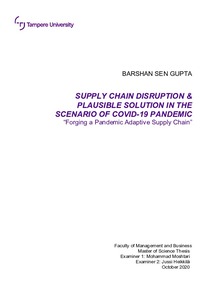Supply Chain Disruption & Plausible Solution in the Scenario of COVID-19 Pandemic; Forging a Pandemic Adaptive Supply Chain
Sen Gupta, Barshan (2020)
Sen Gupta, Barshan
2020
Master's Programme in Industrial Engineering and Management
Johtamisen ja talouden tiedekunta - Faculty of Management and Business
This publication is copyrighted. You may download, display and print it for Your own personal use. Commercial use is prohibited.
Hyväksymispäivämäärä
2020-10-20
Julkaisun pysyvä osoite on
https://urn.fi/URN:NBN:fi:tuni-202010097303
https://urn.fi/URN:NBN:fi:tuni-202010097303
Tiivistelmä
While there is no way to forecast when the vaccination program for the COVID-19 pandemic will initiate, almost every organization has been trying to redesign its process and structure to live coherently with the new unique situation. However, due to the very structure of its globally spread supply chain and its deeply spread web of suppliers, this process is not well explored. Although some companies were prepared better than others, the confidence in global supply chain operation came under vigorous questions when its true agility and resilience were analyzed. To that end, the core concept of this research has been to analyze the different dimensions of supply chain disruption initiated by the COVID-19 pandemic, for developing a guideline for rebuilding it in a more pandemic proof manner.
First, through a comparative analysis, the extreme risks related to the pandemic and similar events are discussed from the theoretical viewpoint. Then, through a detailed analysis of the available resources on the topic matter, seventeen different suggestions from distinguished supply chain experts were identified. Following this, five different strategies were also crafted from these seventeen action plans and a Delphi study consisting of twenty-five supply chain experts as participants asserted strong support for them. The reliability and the authenticity of these suggestions are beyond doubt as they are either famous experts or practitioners on the topic matter. Furthermore, a suggestion like utilizing the Kraljic matrix for defining the extent of supplier relationship management has also come to vicinity through this Delphi research.
Analysis of the published reports brought out the fact that nobody was prepared for such a global disruption. Having said that, the very ideations of efficient and cost-effective supply chain construction principles have been identified as guilty. Overconfidence in existing operations and too much focus on cost-efficient activities has made supply chains susceptible to external risks. Furthermore, in most cases as the true overall visibility of a supply chain was absent, short cited supply chain risk management schemes were in place. All these coupled with the randomness of different national policies and lack of coordination among government and private sectors have resulted in the global supply chain disruption. At the same time panic buying and the sudden spike in demand developed inventory stockouts and raised the question of relying too much on popular supply chain management policies like lean management and just in time inventory management.
The executed research opened some new windows for future research, one of them is to analyze the interrelation among the seventeen action plans and up to what extent they are synergic or divergent. Although it is in the hand of the supply chain managers that how they want to implement the suggested strategies or what will be their sequence; the effectiveness of every one of them has been justified through the study. Successful management of disruptive scenarios requires both proactive alertness and reactive measures so organizations should start rebuilding their supply chain as soon as possible.
First, through a comparative analysis, the extreme risks related to the pandemic and similar events are discussed from the theoretical viewpoint. Then, through a detailed analysis of the available resources on the topic matter, seventeen different suggestions from distinguished supply chain experts were identified. Following this, five different strategies were also crafted from these seventeen action plans and a Delphi study consisting of twenty-five supply chain experts as participants asserted strong support for them. The reliability and the authenticity of these suggestions are beyond doubt as they are either famous experts or practitioners on the topic matter. Furthermore, a suggestion like utilizing the Kraljic matrix for defining the extent of supplier relationship management has also come to vicinity through this Delphi research.
Analysis of the published reports brought out the fact that nobody was prepared for such a global disruption. Having said that, the very ideations of efficient and cost-effective supply chain construction principles have been identified as guilty. Overconfidence in existing operations and too much focus on cost-efficient activities has made supply chains susceptible to external risks. Furthermore, in most cases as the true overall visibility of a supply chain was absent, short cited supply chain risk management schemes were in place. All these coupled with the randomness of different national policies and lack of coordination among government and private sectors have resulted in the global supply chain disruption. At the same time panic buying and the sudden spike in demand developed inventory stockouts and raised the question of relying too much on popular supply chain management policies like lean management and just in time inventory management.
The executed research opened some new windows for future research, one of them is to analyze the interrelation among the seventeen action plans and up to what extent they are synergic or divergent. Although it is in the hand of the supply chain managers that how they want to implement the suggested strategies or what will be their sequence; the effectiveness of every one of them has been justified through the study. Successful management of disruptive scenarios requires both proactive alertness and reactive measures so organizations should start rebuilding their supply chain as soon as possible.
